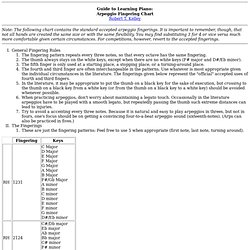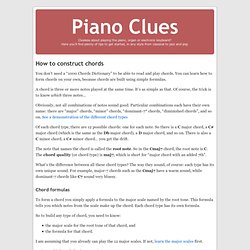

Piano arpeggio fingering. Arpeggio Fingering Chart. Guide to Learning Piano: Arpeggio Fingering ChartRobert T.

Kelley Note: The following chart contains the standard accepted arpeggio fingerings. It is important to remember, though, that not all hands are created the same size or with the same flexibility. You may find substituting 3 for 4 or vice versa much more comfortable given certain circumstances. For competitions, however, revert to the accepted fingerings. General Fingering Rules The fingering pattern repeats every three notes, so that every octave has the same fingering. Return to Guide to Learning the Piano Return to Pedagogical Resources Return to Robert Kelley's Music Website © 2001 Robert T. Broadcast Yourself. Playing Arpeggios on the Piano.
Fundamentals of Piano Practice: Chapter 1: Piano Technique. Untitled. How to construct chords - Piano Clues: Free tips and lessons for playing piano, organ and electronic keyboard. You don’t need a “1000 Chords Dictionary” to be able to read and play chords.

You can learn how to form chords on your own, because chords are built using simple formulas. A chord is three or more notes played at the same time. It’s as simple as that. Of course, the trick is to know which three notes… Obviously, not all combinations of notes sound good. Of each chord type, there are 12 possible chords: one for each note. The note that names the chord is called the root note. What’s the difference between all these chord types? Chord formulas To form a chord you simply apply a formula to the major scale named by the root tone. So to build any type of chord, you need to know: the major scale for the root tone of that chord, andthe formula for that chord.
I am assuming that you already can play the 12 major scales. Let’s put this knowledge into practice. The formula for major chords is: 1 – 3 – 5 We know that the scale for C major is: There are also formulas that contain the symbols b and #. How to Compose Music on Piano. Fundamentals of Piano Practice: Soft Pedal, Hammer Voicing and Physics of the Piano Sound. Grand pianos: The soft pedal is used to change the mood of the sound from percussive to more serene and gentle when the soft pedal is depressed.

It should not be used solely for producing a softer sound because it will also change the timbre. In order to play pianissimo, you will just have to learn how to play more softly. You can produce very loud sounds with the soft pedal depressed. One difficulty with the soft pedal is that it (una corda, or more correctly due corda for the modern grand) is often not indicated, so the decision to use it is often left to the pianist. For uprights, it mostly decreases the volume of the sound. Many pianists do not understand the importance of proper hammer voicing for the soft pedal to be effective.
The use of the soft pedal is controversial because too many pianists are unfamiliar with how it works. In most uprights, the soft pedal causes all the hammers to move closer to the strings, thus restricting hammer motion and decreasing the volume. Piano room: chords and scales.